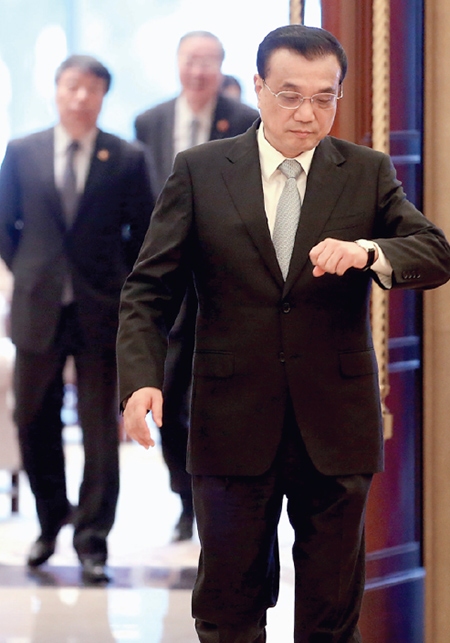High-speed rail set for Hungary, Serbia
By An Baijie (China Daily) Updated: 2015-11-25 07:20China also willing to invest in infrastructure for Baltic, Adriatic and Black sea ports, Li says
 |
|
Premier Li Keqiang checks the time on his way to a series of diplomatic meetings in Suzhou on Tuesday, just hours after he wrapped up a busy trip to Malaysia for the ASEAN annual meeting. Chinese media dubbed Li's diligent working style "Keqiang rhythm". [Photo by Wu Zhiyi/China Daily] |
Two documents for a high-speed railway linking Serbia and Hungary were signed on Tuesday amid China's continuing efforts to boost ties with Central and Eastern European countries.
In a ceremony witnessed by Premier Li Keqiang and Hungarian Prime Minister Viktor Orban, China's National Development and Reform Commission and Hungary's Foreign Affairs and Trade Ministry signed an agreement to cooperate on the development, construction and financing of the Hungarian section of the Hungary-Serbia railway.
Additionally, China Railway International and China Communications Construction Co have signed a contract with the Serbian Ministry of Mining and Energy for the modernization and reconstruction of the Serbian section of the railway.
Construction of the Hungary-Serbia railway will begin this year, Li told an economic and trade forum during the Fourth Summit of China and Central and Eastern European Countries (16+1), which was held in Suzhou on Tuesday.
The train link, which will cut travel time between Belgrade and Budapest from eight hours to three, will be finished in two years, Li added.
China signed a memorandum of understanding with Serbia and Hungary in 2013 to jointly build and update the railway between Belgrade, the capital of Serbia, and Budapest, the Hungarian capital.
The initial project will turn the current line from Belgrade to Budapest into a high-speed railway under an agreement signed last year by Serbia, Hungary and China.
During the forum, Li called for an acceleration of connectivity projects to link development of regional transportation and Internet infrastructure with the China-proposed Belt and Road Initiative.
China also is willing to invest in the construction and upgrading of infrastructure in port areas of the Baltic Sea, the Adriatic Sea and the Black Sea to boost cooperation and connectivity, Li said.
Meanwhile, China will support Central and Eastern European countries in their industrial upgrading with its advanced capacity in automobiles, steel, shipbuilding, port equipment and engineering machinery, the premier added.
"As long as CEE countries use products and equipment made by China, China will provide financing support," the premier said.
During the summit, China and the CEE countries outlined a blueprint for the development of the "16+1" mechanism in the next five years.
Zhou Hong, an expert on international studies at the Chinese Academy of Social Sciences, said that the "16+1" summit serves as a platform for CEE countries to vitalize their economies, organize international industrial cooperation and build infrastructure to help realize their development plans.
Jasna Plevnik, vice-president of the Croatian think tank Geoeconomic Forum, called the 16+1 framework a new model for cooperation between China and CEE countries.




